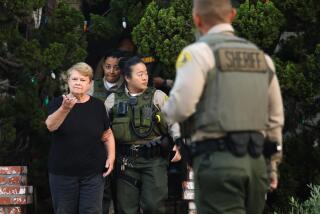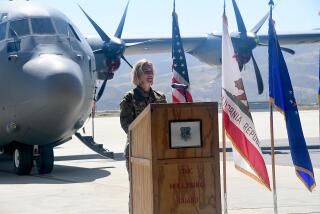3rd Probe of El Toro Officer’s Death Begun : Marines: Col. James E. Sabow’s family, under new legislation, pushes to prove that he was slain in 1991. The ruling was suicide.
- Share via
EL TORO MARINE BASE — For the third time, the military has opened an investigation into the apparent suicide of a top officer here in 1991, and investigators took sworn statements this week in Arizona from two people who contend the colonel was murdered.
The Marine Corps has long sought to put to rest the death of Col. James E. Sabow, 51, an assistant chief of staff at the base who was found shot to death in his back yard just days after he was suspended for allegedly taking improper flights on base planes.
But Sabow’s survivors have vowed to clear his name, hiring forensic and medical experts of their own, filing a lawsuit against the military and pressing for new investigations.
Along with a slew of previously raised questions, they say they can present new evidence showing that blood found in Sabow’s lungs suggests he was murdered. And they have now prodded the military into reopening the case yet again--even after investigators concluded twice before that Sabow killed himself out of despair over the allegations against him.
“This is just the beginning,” said the colonel’s widow, Sally Sabow, who was interviewed Monday at her Arizona home for more than an hour by two Pentagon Inspector General’s investigators who flew in from Washington.
“We know the truth, but our hope is to get it out and make it public--that this was foul play,” she said.
Bill Callahan, a longtime friend of Sabow who served with him in the Marines, said the Pentagon investigators took a sworn statement from him on Tuesday for about 90 minutes at his home in Phoenix, and planned to travel to California from there to do more interviews.
The Inspector General’s office opened the military’s latest investigation into the case in mid-April, said Jack Kennedy, a division director who works in criminal investigations. Previous inquiries in the case have been left to other branches of the military.
The probe grows out of legislation enacted by Congress last year in the wake of growing criticism from survivors who had been frustrated by the way the military had handled investigations into possible suicides.
Congress ordered the Pentagon to review its procedures for investigating possible suicides, and it created a mechanism for families to present evidence to the Inspector General on “material deficiencies” in death investigations. The Sabow investigation is one of several that the office has undertaken following passage of that legislation, Kennedy said.
“We’re obligated to review and re-investigate this if we consider it necessary,” Kennedy said. He declined to discuss any details of the Sabow case because it is an active investigation, but he said the results would be forwarded in a report to Congress.
The mere reopening of the case is good news for Sabow’s supporters.
“We’ve tried for 3 1/2 years now to get a complete and impartial investigation, so I was pretty surprised and pleased by this,” said Callahan, now a pilot for America West.
Sabow’s body was discovered by his wife on the morning of Jan. 22, 1991, lying beside a toppled lawn chair and a 12-gauge double-barreled shotgun in the family’s back yard on the El Toro base. He had been shot once in the head and was dead by the time paramedics arrived.
Military investigators at that time ruled the death a suicide.
The Marine Corps reopened the case in late 1991, under pressure from the family, but the result was the same: A report reviewed by the Navy secretary and the Marine Corps commandant concluded that there was “absolutely no evidence of foul play” and that the threat of publicity over the allegations against Sabow may have caused him to feel “paranoid.”
Sabow and the chief of staff at El Toro, Col. Joseph E. Underwood, lost their jobs after it was alleged that they had flown base planes for golfing jaunts and other improper trips. A few weeks after Sabow’s death, The Times disclosed that the man who fired them--Gen. Wayne T. Adams--had himself used planes for travel to sign his divorce papers and meet his fiancee, and for other questionable trips, and he in turn was dismissed as head of the Marines’ Western air bases.
Sabow’s family has denied that the colonel did anything wrong, and they have speculated that he may have been killed because of information he had on drug trafficking at the base. They have gone so far as to name the person they think was responsible for the murder.
The military, they claim, has tried to cover up the murder to protect itself.
“There never really was an investigation the first time (into Sabow’s death), and there never really was an investigation the second time. It was all pure PR,” said John David Sabow, the colonel’s brother, a South Dakota neurologist who has led the push for a new review. He estimates that family members have spent more than $200,000 in their own investigation.
Within months of Sabow’s death, family members began pointing up possible contradictions in the suicide finding, such as the absence of the colonel’s fingerprints on the shotgun. More recently, their questions have centered on the presence of fresh blood in Sabow’s lungs.
Jack Feldman, chairman of the physiological science department at UCLA and a specialist in neuroscience, signed onto the case with the Sabows about six months ago. He said in an interview Tuesday that he finds it “highly unlikely” that the blood could have gotten into the colonel’s lungs if the suicide had been carried out as ruled by investigators.
The official finding assumes that Sabow would have been able to take several deep breaths of air even after the shotgun blast, drawing the blood into his lungs, he said.
But this is contradicted by the fact that the shotgun blast shattered the brain stem, which controls the chest and diaphragm, Feldman said. Instead, he said the evidence is “consistent with” an alternate theory advanced by the victim’s brother--that Sabow was struck on the head before the gunshot, and drew blood into his lungs as a result of the injury.
It will now be up to the Inspector General to unravel the competing theories. But even as the Sabows have succeeded in reopening some doors in Washington, others remain closed.
Sabow’s brother sent President Clinton a letter asking for a new look at the case, but a March 31 response gave a curt rejection. The White House liaison at the Navy said a review of the case “revealed no reasonable justification for reopening the investigation.”
More to Read
Sign up for Essential California
The most important California stories and recommendations in your inbox every morning.
You may occasionally receive promotional content from the Los Angeles Times.













